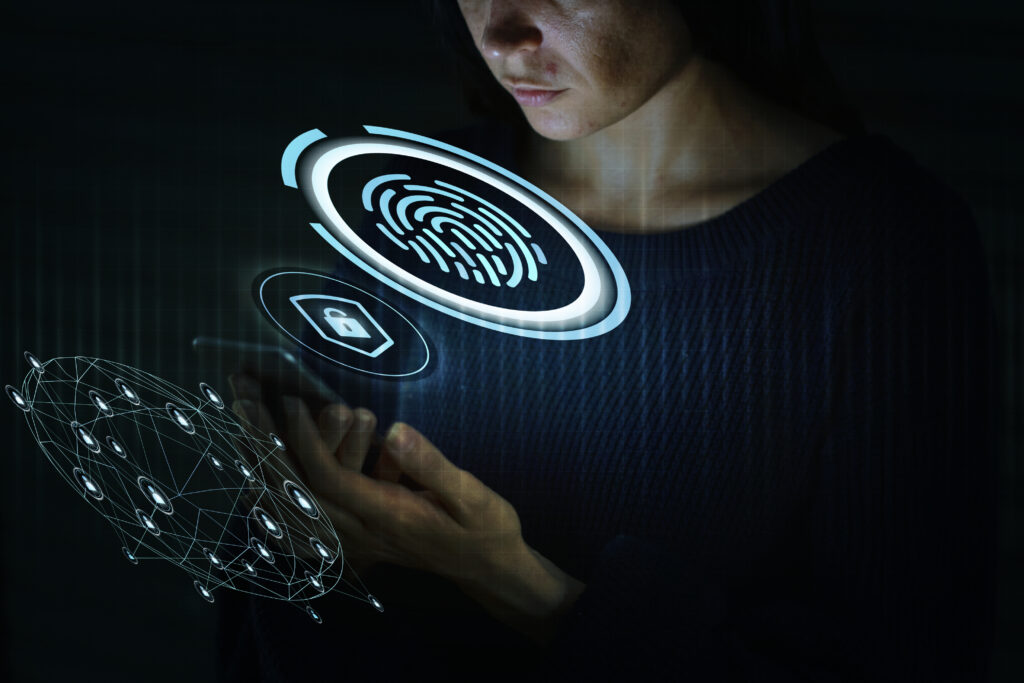1. Introduction
The use of biometric data has grown exponentially in various sectors, from financial institutions to health services. This technology transforms digital authentication, making it faster, efficient and safe. But, like any digital advance, an essential question arises: how to protect this sensitive information reliably?
Cybersecurity Ventures report , more than 30% of cyber attacks designed for 2025 will target biometric data , a significant increase over the 23% recorded in 2023. This alarming growth reflects the invaluable value of these data, which, unlike passwords, are unique, permanent and irreplaceable. What happens if a leak exhibits this information? Identities can be irreversibly compromised, bringing severe damage to individuals and organizations.
Faced with increasingly sophisticated threats , it is possible and necessary to protect biometric data with advanced technologies and effective practices. But what are these technologies? And how can companies prepare to ensure the security of these valuable data?
In this article, we will explore the main risks and challenges of biometric security, we will present the most advanced technologies for protection and highlight the best practices to ensure the privacy of biometric information.
Enjoy the read!
2. Risks and challenges in biometric security
The growing adoption of biometric technologies (such as fingerprints, iris and facial recognition) brings significant benefits in safety and convenience. However, this innovation also has critical challenges related to the protection of these sensitive data. In this section, we will address the main risks associated with biometric security, including data leaks, fraud and the importance of regulatory compliance.
2.1. Leakage and theft of biometric data
Biometric data are unique and permanent, becoming valuable targets for cybercriminals . Unlike passwords, which can be changed in case of commitment, biometric data, once exposed, cannot be replaced . This means that a leak can have lasting consequences for affected individuals.
In 2024, a survey by the Internet Management Committee in Brazil (CGI.br) revealed that 60% of Brazilians who use the internet are concerned about providing their biometric data . This concern reflects the fear that such information can be exposed or used inappropriately, resulting in identity theft or unauthorized access to sensitive systems.
According to the same survey, the increase in biometric data collection by Brazilian companies is also remarkable, from 24% by 2021 to 30% in 2023 . This growth amplifies the risks associated with possible leaks, requiring organizations to implement robust security measures to protect this information.
2.2. Biometric fraud and spoofing
Frauds involving biometrics, such as spoofing (technique in which fraudsters deceive biometric systems using false reproductions such as masks or photos) have become more sophisticated . The absence of robust life verification systems (in English, liveness detection ) increases the susceptibility to these attacks.
spoofing techniques involve:
- Use of Images or Videos : Criminals use high -resolution photographs or videos of victims to deceive facial recognition systems that do not have advanced liveliness detection mechanisms;
- Deepfakes : Use of artificial intelligence to create false images or videos that accurately replicate the appearance of legitimate individuals;
- Three -dimensional masks : The manufacture of realistic 3D masks, replicating the victim's features, is a more sophisticated technique that can deceive less robust biometric systems;
- Digital Manipulation : Fraudsters can replace real -time captured images with digitally manipulated versions, deceiving the system during the authentication process.
And the most vulnerable sectors are:
- Financial : banks and financial institutions that use biometric authentication for access to accounts and transactions are frequent targets;
- Urban Mobility : Transport platforms that employ facial recognition to verify drivers and passengers face spoofing ;
- E-commerce online services : Virtual stores and digital platforms that adopt user authentication biometrics can be vulnerable, facilitating fraudulent purchases and unauthorized access to personal information.
According to CAF report , between January and April 2024, fraud attempts using biometric tools increased from 2.08% to 2.79% compared to the same period as 2023 . This growth indicates that as the adoption of biometrics expands, malicious efforts also grow to explore their vulnerabilities.
On the other hand, the effectiveness of facial biometrics in fraud prevention is evident. According to Serasa Experian , this technology avoided estimated losses of nearly $ 29 billion in Brazil , demonstrating its crucial role in protecting fraudulent transactions. This emphasizes the importance of continuous investments in biometric solutions to safeguard sensitive information.
Despite advances, the growing sophistication of spoofing requires companies to continually invest in advanced safety solutions . In addition, it is essential to educate users about the associated risks and best practices to protect their biometric information.
2.3. The role of regulations and compliance
Biometric data protection goes beyond technology: it also depends on regulations that ensure the ethical and safe use of this information . In Brazil, the General Law on Personal Data Protection (LGPD) classifies biometric data such as sensitive personal data , requiring explicit consent of the holder, clear definition of the purpose of use and the implementation of security measures to avoid unauthorized access and leaks.
Companies that do not comply with the requirements may suffer severe penalties , including fines of up to 2% of revenues, limited to R $ 50 million per infraction, and even partial suspension of data -related activities . In addition, the National Data Protection Authority (ANPD) monitors the use of biometrics, reinforcing the need for compliance with the rules to protect individuals of individuals.
Understanding and adhering to regulations is essential to mitigate legal risks, protecting the company's reputation and ensuring users' trust. That is, investing in data governance is not just a legal requirement, but an opportunity to demonstrate commitment to security and privacy.
The risks are clear, but the good news is that technologies to protect biometric data evolve constantly . In the next section, we will explore the main technological innovations that help companies ensure biometric safety efficiently and reliable.
3. Technologies for biometric data protection
Biometric data security has become a priority as these technologies are widely adopted in various sectors. As we have seen, protecting sensitive information is essential to maintaining users' confidence and systems integrity. Next, we will explore three key technologies that strengthen biometric data protection ; Check it out.
3.1. Encryption and safe storage
Cryptography is a key tool in protecting biometric data. It converts sensitive information into indecipherable codes to unauthorized users , ensuring that, even in the event of interception, data remain protected. Advanced techniques, such as homomorphic encryption , allow data to be processed while still encrypted, ensuring privacy throughout the cycle of use. This is particularly relevant in biometric systems, where data exposure can lead to significant safety risks.
In addition to encryption, safe storage of these data is very important. Implement solutions that integrate robust encryption with rigorous access controls prevents unauthorized accesses and possible leaks. For example, Apple uses data protection technology on its devices , allowing common events, such as telephone calls, occur without compromising user data encryption. This approach ensures that biometric data is always protected even during routine operations .
3.2. Artificial Intelligence in Authentication
Artificial Intelligence (AI) has revolutionized biometric authentication systems, improving both precision and safety . AI algorithms are able to analyze complex patterns in biometric data, such as facial characteristics or fingerprints, identifying anomalies and possible attempts at high efficiency fraud. For example, the combination of AI and Machine Learning (machine learning) allows you to analyze large volumes of biometric data in real time, continually learning from new patterns. This improves fraud detection and reduces false positive and negative.
In addition, AI facilitates the implementation of continuous authentication systems , which constantly monitor the user's behavior to ensure that the initially authenticated person is the same as continues to use the system. This dynamic approach significantly increases safety , adapting to new threats and attack techniques.
3.3. Blockchain and data decentralization
Blockchain technology offers an innovative approach to biometric data protection through decentralization. Blockchain is a distributed digital record that stores information on interconnected and encryption -protected blocks , making data unchanging and highly secure. This structure ensures that any attempt to change is identified as each block depends on the previous one, creating a fraud
resistant chain By storing biometric information on a decentralized network , Blockchain ensures data integrity and authenticity by eliminating unique failure points . This technology facilitates audits, ensures transparency and strengthens compliance with data protection regulations. Innovative companies already use blockchain to create safe authentication systems, such as Humanity Protocol , which employs biometric scanning to verify identities without exposing sensitive information . blockchain integration reinforces safety barriers, making access to biometric data safer and more reliable.
The implementation of these advanced technologies is mandatory for companies to protect their users' biometric data, maintaining confidence and compliance with current regulations. Now we will cover the best practices and recommendations for the effective adoption of these solutions in the corporate environment, ensuring a proactive approach to protecting sensitive information.
4. Best practices to protect biometric information
Implement effective strategies for protecting biometric data not only prevents unauthorized accesses, but also strengthens confidence in the technological solutions offered. Next, we highlight three recommended practices to ensure the integrity of this sensitive information.
- Multifator Authentication (MFA, in English, Multi-Factor Authentication ) : It is about adding extra layers of security to the identity check process , requiring the user to provide multiple forms of authentication before giving access to systems or data. This may include a combination of passwords, tokens and biometric data. By implementing the MFA, even if a credential is compromised, the chances of unauthorized access decrease significantly . For example, in addition to a password, the system may request a fingerprint or code sent to the user's mobile device, ensuring more robust protection;
- Access Control and Permission Management : Establishing strict access controls and efficient permissions management is vital to limit access to biometric data to authorized individuals only. This involves clearly defining who can view or manipulate this information and ensure that access privileges are regularly revised and updated as needed. The implementation of minimum privilege policies, where users receive only essential permissions to perform their duties, reduces the risk of improper exposure of sensitive data. In addition, using solutions that monitor and record access attempts can help identify and quickly respond to suspicious activities;
- Continuous Monitoring and Audit : Constant surveillance of systems that store and process biometric data is crucial to detecting and mitigating possible threats in a timely manner. Implementing monitoring tools that track real -time activities allows the immediate identification of anomalous behaviors or unauthorized access attempts. In addition, conducting regular audits of processes and systems helps ensure compliance with established security policies and identify areas that need improvements . For example, revising logs may reveal suspicious patterns that would otherwise go unnoticed, allowing proactive actions to reinforce safety.
By adopting these practices, companies not only avoid vulnerabilities and risks, but also create a reliable digital environment prepared for future challenges. Protect biometric data with robust strategies reinforces the commitment to safe innovation and strengthens the relationship with customers and partners - values that position companies ahead in an increasingly digital and competitive scenario.
5. The future of biometric security
As technology advances, biometric security evolves to face new challenges and meet increasing data protection demands. In this section, we will explore emerging trends and the role of behavioral biometrics as an additional solution in protecting sensitive information. Check it out!
5.1. Trends and new technologies
The future of biometric security is directly linked to technological innovation. With increasing cyber threats and increasing adoption of biometrics in various sectors, new technologies are emerging to ensure that sensitive data remain protected.
Check out the main trends that shape the future of biometric security:
- Artificial Intelligence Integration : AI is being incorporated into biometric systems to improve accuracy and efficiency in user authentication. Advanced algorithms allow real -time analysis of biometric characteristics , identifying patterns and anomalies faster and more assertively. This integration results in more robust and adaptable systems to various security needs;
- Multimodal Authentication : Combining different biometric methods such as facial recognition and fingerprints is becoming a common practice. This multimodal approach increases safety as it requires multiple identity checks, making it more difficult for fraudsters to circumvent the system . It also offers flexibility to users, allowing the choice of the most convenient authentication method in different contexts;
Use of mobile credentials : The replacement of physical credentials with digital alternatives such as mobile applications and smart devices is on the rise. These options reduce the risk of loss or cloning and improve the user experience , facilitating safe access to systems and services. Companies are adopting solutions that allow the intuitive and safe management of these mobile credentials, aligning with mobility and practicality trends.
5.2. Behavioral biometrics as an additional solution
Behavioral biometrics analyzes unique patterns of users' interaction with devices and systems , for example, typing dynamics, mouse and ways to hold the smartphone . Unlike physical biometrics, which is based on static characteristics such as fingerprints or facial recognition, behavioral biometrics focuses on behaviors that are difficult to replicate by fraudsters.
Check out the main advantages of this technology:
- Improved Security : By continually monitoring user behavior, it is possible to detect suspicious activities in real time, preventing fraud before causing significant damage;
- User Experience Without Actress : By operating in the background, behavioral biometrics does not require additional users' actions, providing continuous and transparent authentication. This improves customer satisfaction, which does not need to deal with multiple verification steps;
- Difficulty in reproduction by fraudsters : Because behavioral patterns are unique and complex, it becomes extremely challenging for malicious individuals to accurately replicate these behaviors to gain unauthorized access.
The implementation of behavioral biometrics, especially when combined with other forms of authentication , offers an additional safety layer. This hybrid approach strengthens the defense against cyber threats, ensuring that only legitimate users have access to sensitive information. Companies in various sectors are adopting this technology to protect transactions and data, recognizing its value in building a safer and more reliable digital environment .
Thus, the evolution of biometric security, driven by technological innovations and the adoption of methods such as behavioral biometrics, represents a significant advance in data protection. And organizations that invest in these solutions are positioned in the forefront of digital security , offering their customers not only efficient services, but also the guarantee that their information is protected against emerging threats.
6. How does skyone guarantee advanced security for biometric data?
At Skyone , biometric data protection is a priority. With the growing adoption of these technologies, ensuring the integrity and confidentiality of information has become essential. Therefore, we offer robust and integrated solutions, aligned with best information security practices to protect our customers data:
- Strong user authentication : We implement multifactor authentication mechanisms, combining passwords, tokens and biometric data. This ensures that only authorized people access sensitive systems, significantly reducing the risk of invasions . Sign-On Single tools , facilitating safe access to multiple applications with a single centralized
login - Advanced Encryption : We use state -of -the -art protocols to protect data in transit and at rest. We guarantee that biometric information remains unreadable to any malicious agent, applying encryption in all processing and storage steps;
- Continuous monitoring and threat detection : Our Security Operations Center (SOC) performs continuous monitoring of systems, allowing proactive detection of suspicious activities and fast responses to incidents. We use behavioral analysis and artificial intelligence tools to identify and mitigate threats in real time;
- Compliance with Regulations : We ensure that our solutions are in accordance with LGPD and other regulations, implementing strict access control policies, constant permissions and audit management to ensure that biometric data is legal and securely treated;
- Safe cloud infrastructure Skyone Autosky platform , we facilitate migration and cloud application management, providing scalability, availability and safety. We offer solutions such as Web Application Firewall (WAF) and Security Manager , which protect applications against various cyber threats;
- Privileged access management : We implement privileged access management solutions that rigorously monitor and control accounts with high permissions, ensuring traceability and preventing improper uses;
- Intrusion Tests : We perform intrusion tests to identify and correct vulnerabilities before they can be explored, evaluating systems resilience and continually improving safety;
- Advanced Backup backup solutions , ensuring that biometric data is copied regularly and can be restored rapidly, ensuring continuity and availability;
- Training and Training : We invest in training and training for our customers' teams, promoting good security practices and the proper use of our tools, strengthening the data protection culture in organizations.
7. Conclusion
The use of biometric data has brought significant advances to digital security, making authentication processes faster and more reliable. However, this evolution also imposes challenges that require a strategic approach to efficiently protecting sensitive information.
As we have seen throughout this article, biometric data protection does not depend on a single solution, but a set of technologies and practices that include advanced encryption, artificial intelligence, blockchain and multifactor authentication. In addition, compliance with regulations such as LGPD plays a key role in the security and governance of this information.
The growing sophistication of attacks requires a continuous commitment to innovation and safety. Companies that adopt advanced technologies and effective data protection policies not only mitigate risks, but also reinforce the confidence of their users and partners , ensuring a safer and more resilient digital environment.
Now, how about deepening your knowledge of sensitive information protection and compliance with regulations? We invite you to read our article “The Importance of Data Governance for compliance with LGPD” , in which we explore best practices to meet legal requirements and ensure data security, strengthening your organization's protection strategy.

Caco Alcoba
With extensive experience in cybersecurity, Caco Alcoba is a true guardian of the digital world. In Skyone's “Caco do Caco column”, he shares sharp cyber threats, data protection and strategies to maintain constantly evolving digital environment.




